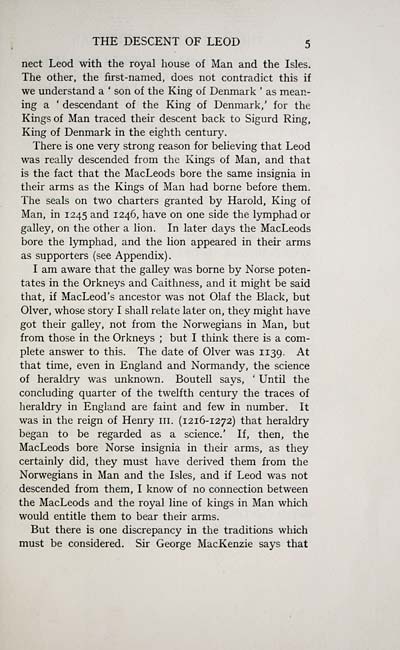Matheson Collection > Macleods of Dunvegan from the time of Leod to the end of the seventeenth century
(35)
Download files
Complete book:
Individual page:
Thumbnail gallery: Grid view | List view

THE DESCENT OF LEOD 5
nect Leod with the royal house of Man and the Isles.
The other, the first-named, does not contradict this if
we understand a ' son of the King of Denmark ' as mean-
ing a ' descendant of the King of Denmark,' for the
Kings of Man traced their descent back to Sigurd Ring,
King of Denmark in the eighth century.
There is one very strong reason for believing that Leod
was really descended from the Kings of Man, and that
is the fact that the MacLeods bore the same insignia in
their arms as the Kings of Man had borne before them.
The seals on two charters granted by Harold, King of
Man, in 1245 and 1246, have on one side the lymphad or
galley, on the other a lion. In later days the MacLeods
bore the lymphad, and the lion appeared in their arms
as supporters (see Appendix).
I am aware that the galley was borne by Norse poten-
tates in the Orkneys and Caithness, and it might be said
that, if MacLeod's ancestor was not Olaf the Black, but
Olver, whose story I shall relate later on, they might have
got their galley, not from the Norwegians in Man, but
from those in the Orkneys ; but I think there is a com-
plete answer to this. The date of Olver was 1139. At
that time, even in England and Normandy, the science
of heraldry was unknown. Boutell says, ' Until the
concluding quarter of the twelfth century the traces of
heraldry in England are faint and few in number. It
was in the reign of Henry iii. (1216-1272) that heraldry
began to be regarded as a science.' If, then, the
MacLeods bore Norse insignia in their arms, as they
certainly did, they must have derived them from the
Norwegians in Man and the Isles, and if Leod was not
descended from them, I know of no connection between
the MacLeods and the royal line of kings in Man which
would entitle them to bear their arms.
But there is one discrepancy in the traditions which
must be considered. Sir George MacKenzie says that
nect Leod with the royal house of Man and the Isles.
The other, the first-named, does not contradict this if
we understand a ' son of the King of Denmark ' as mean-
ing a ' descendant of the King of Denmark,' for the
Kings of Man traced their descent back to Sigurd Ring,
King of Denmark in the eighth century.
There is one very strong reason for believing that Leod
was really descended from the Kings of Man, and that
is the fact that the MacLeods bore the same insignia in
their arms as the Kings of Man had borne before them.
The seals on two charters granted by Harold, King of
Man, in 1245 and 1246, have on one side the lymphad or
galley, on the other a lion. In later days the MacLeods
bore the lymphad, and the lion appeared in their arms
as supporters (see Appendix).
I am aware that the galley was borne by Norse poten-
tates in the Orkneys and Caithness, and it might be said
that, if MacLeod's ancestor was not Olaf the Black, but
Olver, whose story I shall relate later on, they might have
got their galley, not from the Norwegians in Man, but
from those in the Orkneys ; but I think there is a com-
plete answer to this. The date of Olver was 1139. At
that time, even in England and Normandy, the science
of heraldry was unknown. Boutell says, ' Until the
concluding quarter of the twelfth century the traces of
heraldry in England are faint and few in number. It
was in the reign of Henry iii. (1216-1272) that heraldry
began to be regarded as a science.' If, then, the
MacLeods bore Norse insignia in their arms, as they
certainly did, they must have derived them from the
Norwegians in Man and the Isles, and if Leod was not
descended from them, I know of no connection between
the MacLeods and the royal line of kings in Man which
would entitle them to bear their arms.
But there is one discrepancy in the traditions which
must be considered. Sir George MacKenzie says that
Set display mode to: Large image | Transcription
Images and transcriptions on this page, including medium image downloads, may be used under the Creative Commons Attribution 4.0 International Licence unless otherwise stated. ![]()
| Early Gaelic Book Collections > Matheson Collection > Macleods of Dunvegan from the time of Leod to the end of the seventeenth century > (35) |
|---|
| Permanent URL | https://digital.nls.uk/80472222 |
|---|
| Description | Items from a collection of 170 volumes relating to Gaelic matters. Mainly philological works in the Celtic and some non-Celtic languages. Some books extensively annotated by Angus Matheson, the first Professor of Celtic at Glasgow University. |
|---|
| Description | Selected items from five 'Special and Named Printed Collections'. Includes books in Gaelic and other Celtic languages, works about the Gaels, their languages, literature, culture and history. |
|---|

